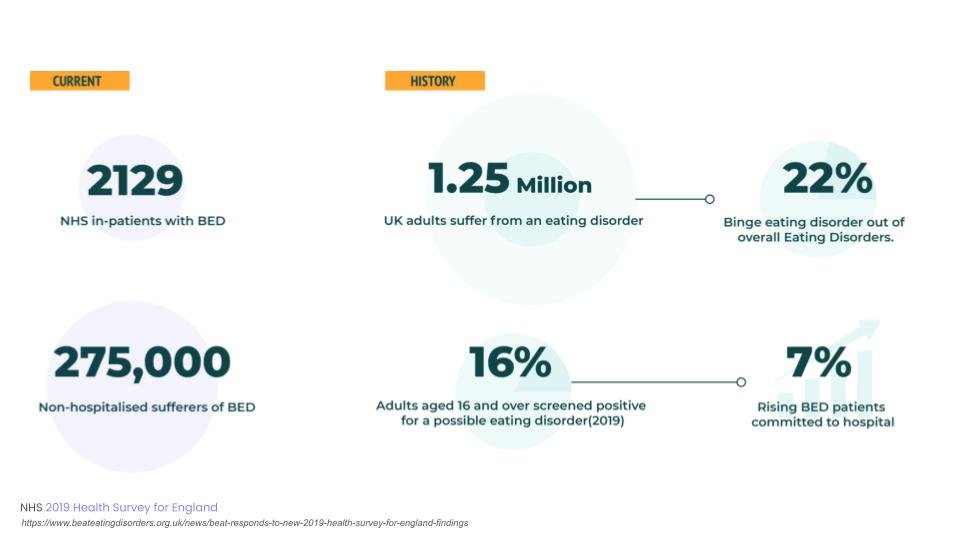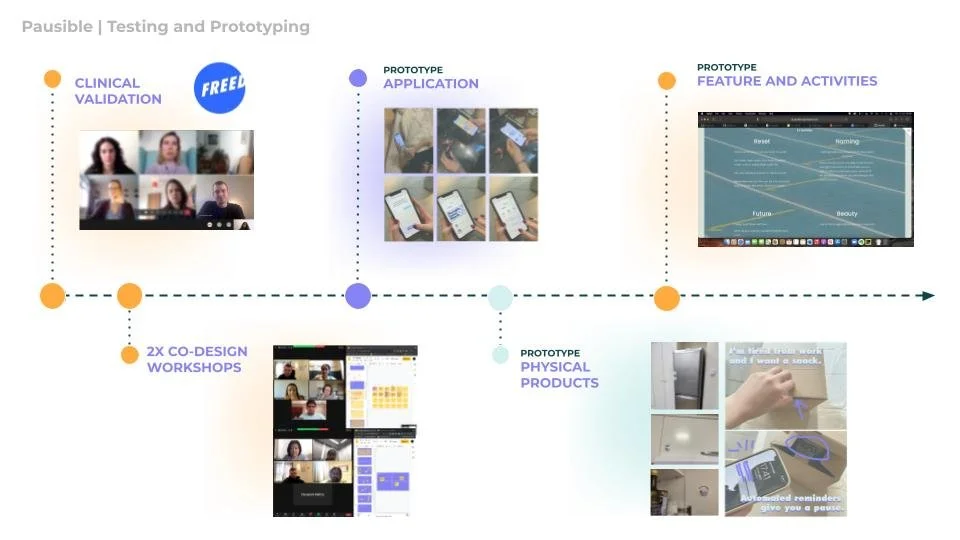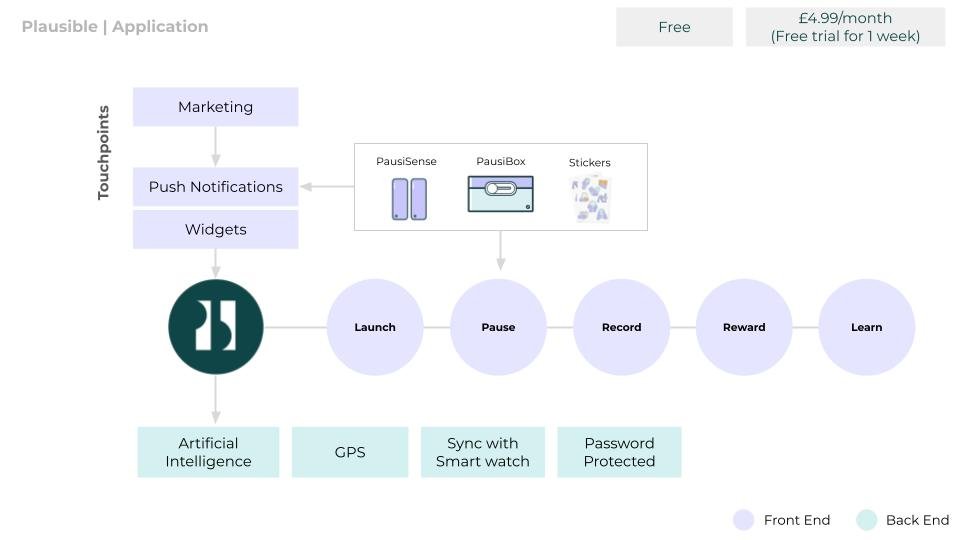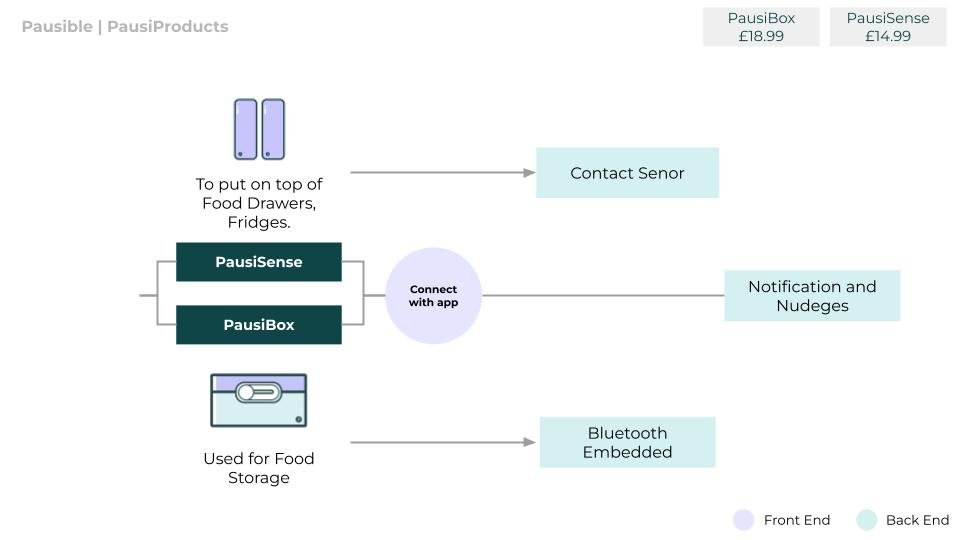Pausible - NHSx
Our Collaborations:
This is a student project at the Royal College of Art, Service Design Department. NHSX approached us with a brief to build services/products and interventions in mental health. NHSx is the digital division of NHS which is the national healthcare service of UK.
Our Brief:
To create a service in the digital space of mental health disorders in the UK for Children and Young People(CYP). We chose Eating disorders(ED) specifically within the mental heath issues as it lacked services in the digital space that help users to understand and prevent it from becoming a chronic disease.
Our Solution:
Pausible is a service that helps people who struggle to control their food cravings and share an unhealthy relationship with food by reducing impulsive eating patterns and behavior to enable conscious decision making such that it does not become a lifestyle limitation.
Challenge
Currently, there are approximately two thousand NHS in-patients with Binge eating disorder (BED) in market size of over two hundred thousand non-hospitalized sufferers. With the market growing annually by 7%, there is a huge unmet demand for health services in this sector.
Research
We conducted interviews, did a survey and executed multiple social media conversations on Reddit and various facebook forums to understand behaviors and the journey of young people that have eating disorders and struggle with eating disorders(ED). As every ED is very different from each other we narrowed down our focus onto Binge Eating disorders. As we researched further on existing services we realized the lack of service in the prevention sector.
Through the research, we understood that cravings are different from hunger and are the first initial steps to get into the Binge eating disorder cycle. We then divided our target sector into 3 different user groups, with a mix of users who find it difficult to manage their cravings and users who are on the borderline of getting a Binge Eating Disorder.
-
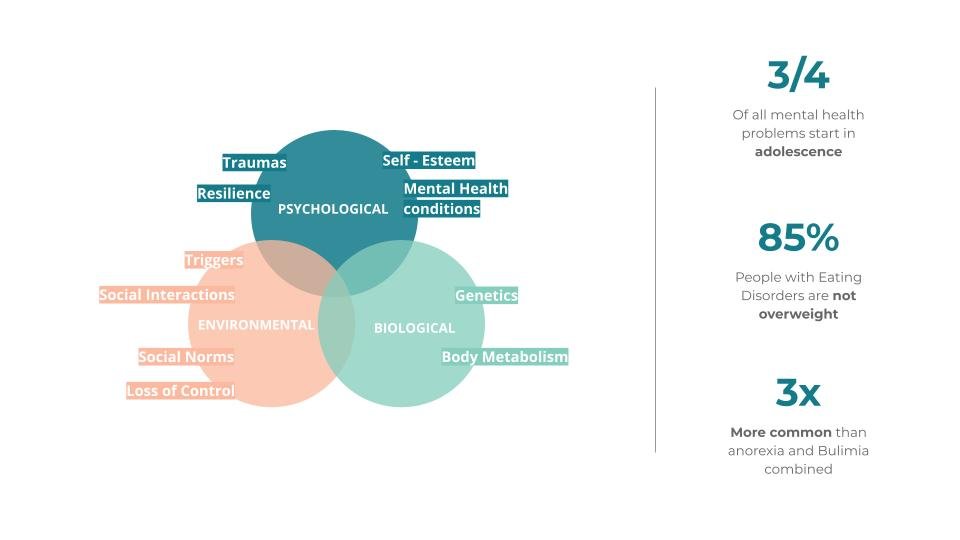
Binge Eating Disorder Landscape
With our research, we began analyzing the cause and effect of a binge eating disorder(BED). BED is usually overlooked during the early stages as it lacks awareness in young adults. Over the years due to social media, social and environmental pressures have also increasesed as a cause of BED.
-

Qualitative and Quantitative Research
Mental health and especially binge eating diorder(BED) is a very sensitive topic. One of the major challenges was to find users that were suffering from it. We moved away from traditional research methods and started looking at social platforms where users would find it more comfortable to discuss these topics in anonymity. We used platforms like Reddit and Facebook to connect with them. For qualitative research, we got in touch with people that were diagnosed with BED and either have recovered from it or were in the stage of recovery. This helped us to map out their journey from start to end and identify the various pain points along it.
-

Binge Eating Disorder Cycle
Through user surveys and clinical research that were conducted, we looked at binge eating as a vicious cycle of eating and regretting that can quickly spiral into a severe eating disorder if left untreated. It is easily triggered by internal and external stimuli, it becomes an escape mechanism to manage emotions of discomfort and stress. Cravings are separate from hunger and are specific learned behaviors.
We narrowed our focus on the early prevention stages through craving management.
-

User Segments
We identified 3 types of users for our service. First is the casual snacker whose behaviors portray boredom and work stress that acts as triggers for their snacking. Then, is the Trend Catcher, they love exploring food and looking at food content on social media which influences their cravings. Lastly, the third, is an action first, who recognizes they are in the early stages of Binge eating disorder. Food for them acts as an escape mechanism from stressful events in the past or present, for the cycle has crossed the prevention stage, and need to seek professional help for this.
Problem Definition
How might we help users to curb their cravings so that overeating and unhealthy binge eating does not become a lifestyle habit and develop into binge eating disorder?
Solution: Pausible
Pausible is a service that helps people who struggle to control their food cravings or share an unhealthy relationship with food by reducing impulsive eating patterns and behaviour to enable conscious decision making so that it does not become a lifestyle limitation. It uses informed cognitive-behavioral research and choice architecture to nudge behavior change and support the creation of new mindsets that can prevent serious eating disorders in the future. Primarily, our service is a downloadable application on app stores, as well as integrating physical and digital touchpoints to achieve maximum impact on user outcomes and reduce overexposure to notifications. Our app works in sync with our physical products, which can be purchased from online stores, to manage cravings in users.
Validation and Competior Analysis
We develop our service through iteration and five rounds of testing and prototyping, we spoke to experts from KCL Eating Disorders Research Group last term and tested the principle of our 90-second pause.
We also conducted two co-creation workshops, we worked with them to build the activities and understand their behaviors better to create different varieties of activities during the pause. We conducted UX testing as well with them to test the flow of the application. We received various feedback that were implemented in the next stage of prototyping. Finally, we created a website and promoted it in some offline supermarkets, and got more feedback based on our main features.
Competitor Analysis
Applications for eating disorders usually have two main function modules: behaviour recording and coping skills, a selection within 3 subordinate function modules: symptom assessment, help + information, and progress records. These applications are designed for privacy and personalization, along with many input needs in the record section. It requires therefore a strong user commitment to enter their behavioural status. As for the coping skill section, it also needs very strong motivation from users to get into and follow the activities in applications. However, none of the the applications cater users to get involved in recording, and only Brighter Bite serves guidance alongside how to use coping activities. All the applications are free to download and use, and for some, they have In-App purchases.
How does it work?
Pausible’s application interface consists of four modules: Pause, Reward, Learning, Record. When a user downloads the application onto their device, Pausible captures basic user data to understand users’ preferences so the interface can be personalized to their needs.
Pause activities are the core functionality and feature of our application. Based on the Cognitive Behaviour Therapy (CBT) techniques to challenge negative thinking, induce distraction from cravings as well as positively manifest outcomes through creative visualization activities over durations from 90secs to 20min. This timeframe is set by clinically validated research showing the duration of cravings and impulsive behaviors will peak and then dissipate over the course of 20 minutes, even though it may feel like it will last forever. The Pauses direct users to recommendations for reflective activities and exercises tailored to their specific needs and goals set on the app, giving them time to reflect on their daily food intake decisions and patterns thus motivating them to make healthier food choices. These activities will help users understand and identify their personal triggers and customize the app to help manage them. The settings menu on the app allows a user to customize the service according to goals and modify the notifications they receive, add widgets to their device home screen, generate pop-up notifications for food delivery applications as well as sync the app to their smartwatch.
Physical products are available for purchase on the online store. The physical presence helps spread visual awareness of the brand and has a lasting visual impact, drawing in new customers and increasing user engagement, reducing drop-off. Working with the app to enhance the tangibility of the behavioral nudges by creating physical architecture, it serves as a great advantage to the user outcomes of having physical touchpoints present at the time and location whenever required or likely to experience food cravings.
PausiBox: A sensor-enabled food storage box that helps you take the pause to convert the unconscious response to conscious decision.
PausiSense: A set of two sensor-based stickers which can be attached to your food cupboard, refrigerator, or in locations you identify most triggering and vulnerable. These stickers capture data and nudge users to pause when they are in close proximity to these locations.
TEAM MEMBERS:
Wei Huang | Yuxin Wang | Alex Burdett | Hanyuan Xue | Shruti Agerwala | Priyanjali Rane
